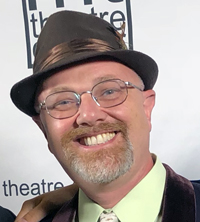By Eric George Tauber

CINCINNATI, Ohio — The Museum Center in Cincinnati, Ohio, was originally built as the Union Terminal train station in 1933. As travel by train declined, the building received its last passengers in 1972, later re-opening as an Amtrak station in 1991 and then being refurbished as the Museum Center in 2018. This impressive building houses a Children’s Museum, the Museum of Natural History & Science, an Omnimax Theater, the Cincinnati History Museum, and most recently the Nancy & David Wolf Holocaust & Humanity Center. It was to this last institution that Temple Sholom organized a curated tour with one of its docents, Fred Miller.
At the top of the stairs, we were greeted by sculptures that look like a swirl of papers in a strong wind. There were images of documents such as travel papers and passports, both forged and legit, that belonged to survivors. These papers lead us down a flight of stairs into the Holocaust Museum. Rather than overwhelm us with photographs of skeletal bodies with vacant stares or piles of dead bodies in mass graves, this facility feels like walking into a graphic novel, the likes of Art Spiegelman, Will Eisner, or Joe Kubert. One powerful image of Kristalnacht portrays a grand synagogue with flames slowly rising behind it in 2D animation.

Six million is an overwhelming number. It was one third of world Jewry at the time. The number jumps to more than 11.5 million when you include the Roma/Gypsies, Gay men, Jehovah’s Witnesses, Communists, dissidents, the disabled and others whom the Nazis considered “Untermenschen.” Rather than let us be overwhelmed, this museum largely focuses on six survivors who rebuilt their lives in Cincinnati, telling their stories in detail. This makes the Holocaust more relatable as we can see these six as our elder neighbors and friends.
Our docent’s father, Al Miller (originally Müller) was born in Germany as the son of a prosperous businessman who owned a textile factory. The Müllers were so well-to-do that Al first learned to ride a bicycle around their dining room. Then came the discriminatory Nuremberg Laws making it impossible for Jews to do business and upending their lives. Fred Miller pointed out that these laws in Germany were based on America’s Jim Crow Laws. Only in Germany, some could avoid persecution if they were mischlinge, half-Jewish/half-Teutonic. In America, one drop of “African blood” made you “colored” even if you had fair skin. The same principle was applied to the internees of Japanese Internment Camps.
Getting from Europe to America was not an easy process. Quota Laws regulating how many people could come from each nation were strictly enforced. Immigrants were best able to come if they had a sponsor, someone who agreed to be financially responsible for them while they got on their feet. One featured document is a heart-breaking letter to a relative asking for forgiveness because he could not afford to sponsor them, promising to do so when his fortunes turned.
Those immigrants who did come in rode trains into the very station that now tells their stories. They were told that Cincinnati was “a German city.” But, when they got here, nobody spoke German.
“It didn’t start with bullets. It started with words.”
—Al Miller
We can’t really understand how the Holocaust happened if we don’t examine what led up to it. The Nazis were plentiful in their propaganda, caricaturing Jews as rats, spiders and greedy goblins, vermin to be exterminated and not people to be valued. Long held prejudices were inflamed by hateful rhetoric, preposterous conspiracy theories and outright lies. When you tell your audience what they want to hear, they tend to hearken with uncritical ears.
Actual goose-stepping, armband wearing, window smashing Nazis were a minority in Europe. The majority were bystanders, looking on with horror, or looking away with shame, feeling helpless as the Brown Shirts punched down on the vulnerable. Yet the greatest minority of them all were the “Upstanders,” those who did whatever they could to defy the regime, saving innocent lives at great risk to their own. This is the ultimate message that the Cincinnati Holocaust Museum wants to leave us with. It is up to each of us to be an Upstander, to speak up, to march and to defy the forces of cruelty and injustice. This is a message that all of society would do well to heed.
*
Now residing in Cincinnati, Eric George Tauber was a San Diego based freelance writer specializing in coverage of the arts. He may be contacted via eric.tauber@sdjewishworld.com